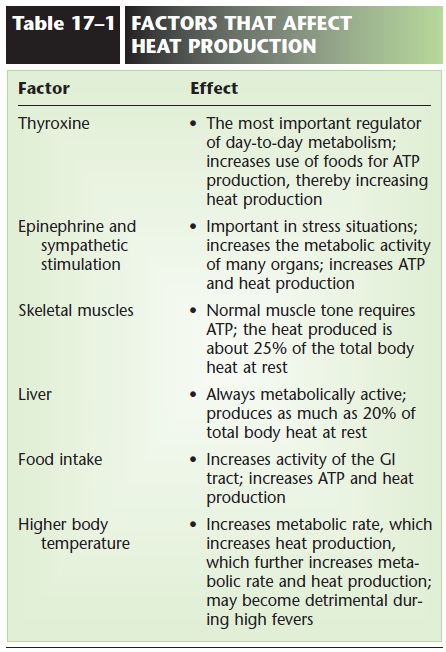Chapter: Essentials of Anatomy and Physiology: Body Temperature and Metabolism
Heat Production - Body Temperature
HEAT PRODUCTION
Cell respiration, the process that releases energy from food to produce ATP, also produces heat as one of its energy products. Although cell respiration takes place constantly, many factors influence the rate of this process:
1. The hormone thyroxine (and T3), produced by the thyroid gland, increases the rate of cell respiration and heat production. The secretion of thyroxine is regulated by the body’s rate of energy production, the metabolic rate itself. When the metabolic rate decreases, the thyroid gland is stimulated to secrete more thyroxine. As thyroxine increases the rate of cell respiration, a negative feedback mecha-nism inhibits further secretion until metabolic rate decreases again. Thus, thyroxine is secreted when-ever there is a need for increased cell respiration and is probably the most important regulator of day-to-day energy production.
2. In stress situations, epinephrine and norepineph-rine are secreted by the adrenal medulla, and the sympathetic nervous system becomes more active. Epinephrine increases the rate of cell respiration, especially in organs such as the heart, skeletal mus-cles, and liver. Sympathetic stimulation also in-creases the activity of these organs. The increased production of ATP to meet the demands of the stress situation also means that more heat will be produced.
3. Organs that are normally active (producing ATP) are significant sources of heat when the body is at rest. The skeletal muscles, for example, are usually in a state of slight contraction called muscle tone. Because even slight contraction requires ATP, the muscles are also producing heat. This amounts to about 25% of the total body heat at rest and much more during exercise, when more ATP is produced.
The liver is another organ that is continually active, producing ATP to supply energy for its many functions. As a result, the liver produces as much as 20% of the total body heat at rest. The heat produced by these active organs is dispersed throughout the body by the blood. As the relatively cooler blood flows through organs such as the mus-cles and liver, the heat they produce is transferred to the blood, warming it. The warmed blood circu-lates to other areas of the body, distributing this heat.
4. The intake of food also increases heat production, because the metabolic activity of the digestive tract is increased. Heat is generated as the digestive organs produce ATP for peristalsis and for the syn-thesis of digestive enzymes.
5. Changes in body temperature also have an effect on metabolic rate and heat production. This becomes clinically important when a person has a fever, an abnormally high body tempera-ture. The higher temperature increases the meta-bolic rate, which increases heat production and elevates body temperature further. Thus, a high fever may trigger a vicious cycle of ever-increasing heat production.
The factors that affect heat production are summa-rized in Table 17–1.

Related Topics